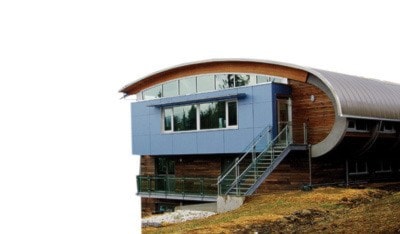Emerging from a hillside overlooking Baynes Sound, at the end of an alabaster-white road made of oyster shells, is a building that, if you look hard enough, resembles the shape of a clam.
At least that’s what the architects were thinking of when they designed the Deep Bay Marine Field Station.
A silver-grey metal roof curves over a mostly-nautical themed building. There’s a steel gangplank leading to two heavy wood doors. A portion of the exterior siding resembles cedar lobster traps, designed to fade and age to look just like that. Push inside and massive glass windows look out over the ocean. The large, wood interior with its curved rafters also draw the eye. Yet, both of those will eventually pale in comparison to a planned whale skeleton that will hang there. Until that whale rots in the ground somewhere near Sooke, however, the view over the sound and its scallop and oyster beds will just have to do.
The facility, run by Vancouver Island University, uses materials and contractors from as local sources as possible. It’s designed to house students, researchers, dignitaries and community groups from throughout the region as it embarks on various projects, economic, academic and social.
A grand opening was held June 23 to recognize the various funding partners, area First Nations, designers and contributors, but it has been running for some time already, says manager Brian Kingzett.
One of the lab spaces has been growing algae, where VIU students like Sarah Leduc harvest it to feed to various oyster and geoduck clam specie. Already, there are many thousands of baby geoducks on the grow — clams that are highly valued on the export market. Windows on the mezzanine level allow views into the labs, most of which are still empty.
That’s something that will change quickly, said Kingzett, mentioning that a graduate student from Spain has already applied to work at the facility to further their own shellfish research.
Despite a kind of lonely or empty feeling to the spacious first floor — which Kingzett assures has been busy with various community meetings, a wedding and other functions — there is a lot going on the research station. In addition to a green design, with construction methods and materials of interest to the development community, VIU students are involved with various on-site projects.
There’s a riparian area enhancement effort on a nearby salmon-bearing stream. Solar power technology is being blended with oyster farm float construction designs to better circulate food and oxygen to the facility’s oyster beds. And the facility itself is using innovative technology to keep it in filtered ocean water and power. The room housing the heat and water pumps that keeps the place going is a maze of complex instruments and machinery — all of which can be controlled remotely.
The facility has come a long way, continued Kingzett, from five years ago when the initial idea was to have only a shellfish farm and steel research shed on the site.
The Deep Bay Marine Field Station is sort of an aquatic Milner Gardens and Woodland. Milner, in Qualicum Beach, is the VIU-run botanical research facility that once played host to the Prince and Princess of Wales in 1986 and Queen Elizabeth and Prince Phillip in 1987. It’s this level of public involvement that Kingzett hopes to duplicate in Deep Bay.
“I’m the equivalent of Geoff Ball at Milner,” said Kingzett, referring to the current manager of the garden and woodland.
Like Milner, the station blends academic research with public participation. It’s rooms can be rented out, for instance, that helps both groups looking for meeting space and VIU to make a bit of money to cover costs. There’s also a kitchen run by the university’s culinary institute, where prospective chefs can try their hand at preparing shellfish dishes (after all, the facility’s focus is on the health of the local food supply, said Kingzett). The combination makes for a unique structure on B.C.’s West Coast. And it’s already having an impact on neighbours.
Researchers and visitors to the facility, said Kingzett, require accommodation. The two bunk rooms they have are OK, but they’ll be turning to local service providers when there are a lot of people on site. They are also located near land owned by a Lower Mainland development company. Kingzett said the design of the station, its local materials and goal of blending in with its surroundings, has influenced plans for a large, new residential area in the works for both sides of the nearby Highway 19A.
“It’s important to develop responsibly on the coast,” Kingzett said. “So, in order to preach that, we had to do the same with our green building.”
That effort, currently being reviewed and certified, earned the facility — and lead architect Larry McFarland — a 2011 National Green Buildings Award through Sustainable Architecture and Building magazine — one of only seven such awards across Canada, said Kingzett.
Eventually, the facility hopes to become not only a state-of-the-art research station, home to upwards of 15 full-time students on site at peak capacity, but a tourist destination as well.
“Our job is to educate,” said Kingzett, himself a marine biologist. “and I can see it working well in this case.”
To find the field station and for more information, visit http://viudeepbay.com.
